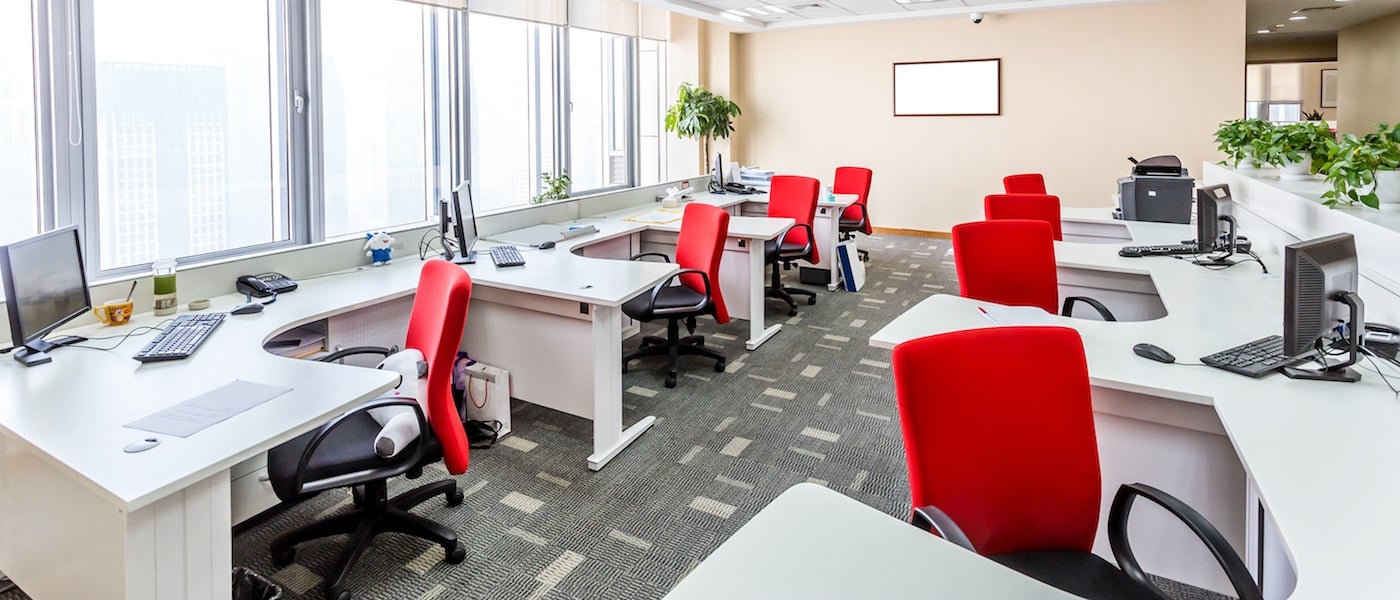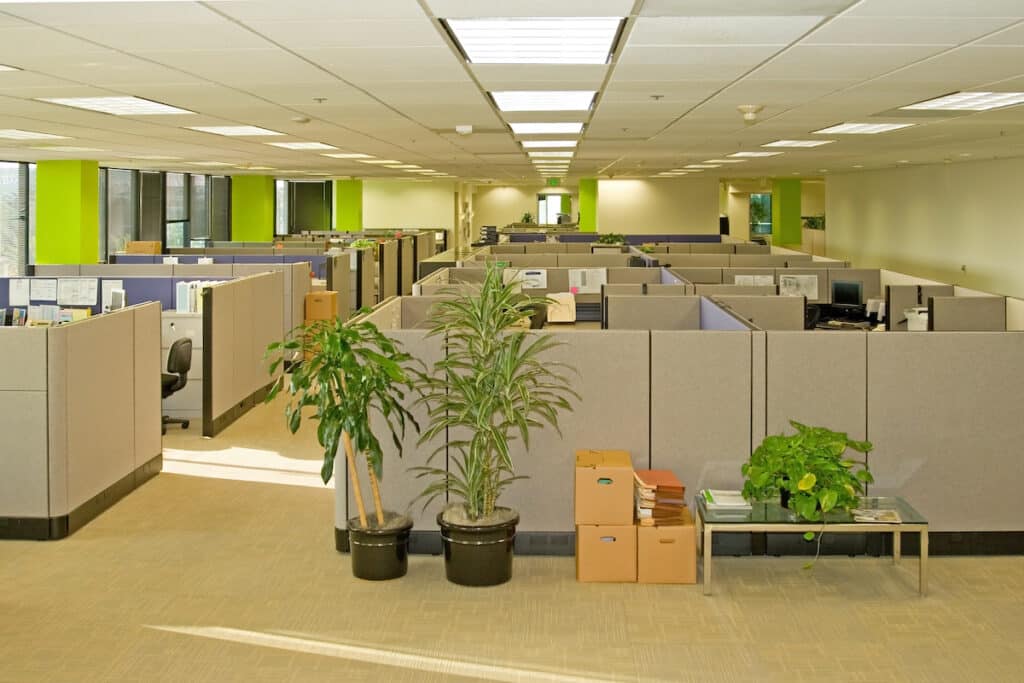If you ask employees to describe their ideal workspace, many would probably describe a spacious corner office with sweeping city views, a fully stocked mini-fridge and a cozy sofa ideal for power naps. Except for a fortunate fraction of workers, the reality is nowhere near this ideal. This ideal does serve as a brass ring to motivate employees, though! Most employees work in either an open workspace or a cubicle, and there are pluses and minuses to both setups.
If you’ll soon be moving offices, now is the ideal time to consider a change. Shaking up the status quo work environment with a bit of office reconfiguration can energize your team. Before you decide how to lay out your new office, consider the pros and cons of open workspaces versus cubicles, consult your employees, and weigh the costs and space constraints. Often, change has a domino effect (in a good way!)
When Open Workspaces Are Best
What some businesses probably consider a drawback of open workspaces — lack of privacy — other businesses embrace. Often called office hoteling or benching, open workspaces encourage communication, brainstorming, and creativity that are essential to success in collaborative and creative environments.
Types of Businesses That Can Benefit From Open Workspaces:
Open workspaces can work in a variety of office environments; however, creative businesses often prefer open workspaces so employees can bounce ideas off of one another. Businesses that tend to gravitate toward open workspaces include:
- public relations firms
- marketing firms
- advertising agencies
- think tanks
- nonprofits
- architecture firms
The Pros and Cons of an Open Office Workspace
- Pro: Communication. Open office space encourages collaboration, creativity, and a team environment.
- Pro: Flexible. Seating arrangements can easily and quickly be reconfigured to best meet current needs.
- Pro: Visually pleasing. Many people prefer the look and trendy feel of open office designs.
- Con: Lack of privacy. Lack of privacy in open workspaces has been linked back to employees feeling uncomfortable, angry, and having negative feelings about their workplace.
- Con: Distractions. Employees are more easily distracted because they can see and hear much more in an open workspace.
- Con: Anxiety. With open space comes the increased likelihood that employees will feel anxious about continually being watched and monitored by their bosses.
When Are Cubicles Best?
Although the majority of U.S. workplaces embrace an open-concept approach, research shows that cubicles actually increase worker productivity, which is obviously advantageous for all industries. These pro-cubicle studies conclude that employees in open workspaces are less able to concentrate because they’re more likely to become disrupted.
Cubicles give workers much-welcomed privacy. They also serve as noise and visual buffers to minimize distractions so employees can maintain their focus.
Types of Businesses That Are Benefited by Cubicles:
Workspaces with cubicles are necessary in some industries where privacy is essential including:
- banks
- accounting firms
- tax preparation businesses
- payday lenders
- law firms
Cubicles also provide an ideal office setup for businesses whose employees don’t have offices but regularly entertain customers in the office. Even if employees don’t mind a lack of privacy, customers might.
Businesses whose employees spend much of their time on the phone (making sales calls or dispatching drivers, for example) find that open workspaces simply aren’t conducive to the job at hand. If employees can’t hear the voice on the other end of the line clearly, and vice versa, that’s not an effective workspace environment.
Cubicles have drawbacks, though. Typically, a workspace with cubicles fits fewer employers into the space footprint than an open workspace. Another drawback is that companies whose workers are isolated in cubicles for much of the workday often have less of a team mentality. An open workspace is akin to an extroverted work environment, whereas a cubicle-filled workspace is similar to an introverted workspace where employees tend to keep to themselves.
Thinking about switching from cubicles to an open workspace? Find out, “Can you convert cubicles into open workspace?”
Pros and Cons of Cubicles
- Pro: Privacy. Cubicles provide privacy and a sense of personal space.
- Pro: Noise reduction. They provide a physical barrier that absorbs sound and reduces distractions.
- Pro: Help control germ exposure. Cubicles can be very helpful in preventing or reducing the spread of germs and infectious illnesses throughout the office. (However, it’s always best that a sick employee remains away from the office.)
- Con: Discourages team collaboration and communication. With physical barriers, it takes more effort for employees in cubicles to communicate and collaborate.
- Con: Visual barriers. There’s less transparency for supervisors to keep tabs on their employees. Probably a pro for employees, but a con for managers or bosses that prefer to keep an eye on their employees.
- Con: More expensive. Changing office layout and design are more difficult when cubicles are involved, as they must be disassembled and reassembled properly.
Some Offices Embrace a Hybrid Workspace That Delivers the Best of Both Worlds
What will the workspace of the future look like? That remains to be seen, but many companies are experimenting with a combination of cubicles with flexible, movable dividers and communal spaces that encourage collaboration. In some industries, what works best is black or white. An office in which employees spend the vast majority of their time making phone calls — to sign up new clients or raise money — probably won’t benefit from an open floor plan. It will probably suffer because the noise level can become bothersome.
In many businesses, though, employees can benefit most from a mix of private time spent in a cubicle broken up by collaborative sessions in a communal open space. There is no “one size fits all” solution. The first step toward identifying what’s best for your business is to ask your employees.
Related Read: A Better Alternative to the Open Office Concept
If you’ve been tasked with an out-of-town office move or installation, you’ll want to make sure that you a comprehensive to-do list.
If you have more questions or need more expert advice talk to one of our experienced office furniture installers at Houston Installation Services.







